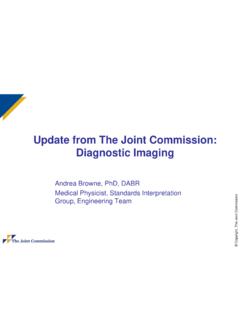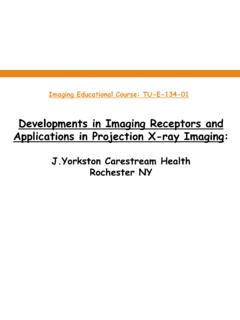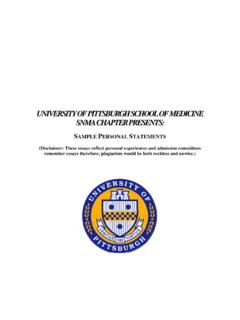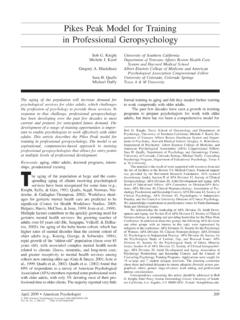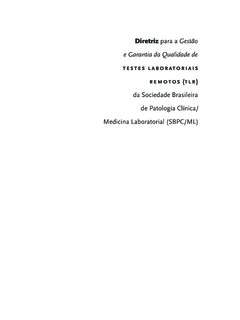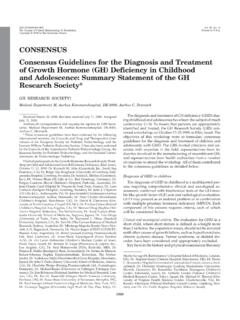Transcription of SBRT Treatment Planning: Practical Considerations
1 SBRT Treatment planning : Practical ConsiderationsLinda Hong, Medical CenterAlbert einstein college of MedicineBronx, New YorkI have no conflicts of interest to The Basic Principles of SBRT Treatment planning Conventional fractionated plan vs. SBRT plan Cranial SRS plan vs. SBRT plan Practical Considerations on SBRT Treatment planning Spine Lung Liver Lessons learned from our experiencesStereotactic Body Radiation Therapy (SBRT) Fractional dose >5 Gyrange: 5 Gyto 34 Gyper fraction Number of fractions <5range: 1 to 5 Safe delivery is of utmost importance due to high fractional dose and small number of fractions. Montefiore- einstein SBRT Experiences Started 1stSBRT Spine 1/2008 Started 1stSBRT Lung 4/2008 Started 1stSBRT Liver 8/2008 About 2 new SBRT cases weekly ever since Machines Varian Trilogy or Truebeam Eclipse TPSS pine1- 3 lesions Single Fraction: 16 Gy Three Fraction: 24 Gy (8 Gy per fraction)LungPeripheral Lesions Three fractions: 60 Gy (20 Gy per fraction)Central Lesions Five fractions: 50 Gy (10 Gy per fraction)LiverMetastasis If lesions > 2cm from Porta Hepatis/Bile Duct: Three Fractions 20Gy x 3 If lesions 2cmfrom Porta Hepatis/Bile Duct: Five Fractions 10Gy x 5 Hepatocellular Carcinoma Five fractions: 30-50 Gy (depends on Veff)Montefiore- einstein Cancer Center (MECC) SBRT RegistryRTOG SBRT Protocols 0631 Spine 0813 and 0915 Lung 0438 LiverThese protocols specify detailed requirements for Treatment planning .
2 Dose PrescriptionTarget Coverage Dose ConstraintsThe Basics of Treatment planning for SBRT The goal of SBRT Treatment is to ablate tissues within the PTV, these tissues were not considered at risk for complications. Dose inhomogeneity inside the PTV was considered acceptable (potentially advantageous) and not considered a priority in plan point dose up to 160% of Prescription Dose is common for SBRT plans. The main objective of the plan is to minimize the volume of those normal tissues outside PTV receiving high dose per MarginIf beam margin is close to beam penumbra (5-6 mm) Homogeneous PTV dose, Maximum dose about 110% of Prescription Dose (PD).Dose fall off outside PTV is slowPTVBeam MarginIf beam margin is much less than beam penumbra (0-2 mm) Inhomogeneous PTV dose, Maximum dose ~ 125% or more of fall off outside PTV is fastPTVPTVFIG. 3. a Conformity index (Ratio of PD Volume to PTV Volume) vs.
3 Homogeneity 1. Homogeneity index (Ratio of Maximum PTV Dose to the PD) vs. beam margin. Hong et al.: LINAC-based SRS: Inhomogeneity, conformity, and dose fall off, , Vol. 38, No. 3, March 2011 Cranial SRS PlanningSanford L. Meeks et al Int. J. Radia. Onc. Biol. Phys., Vol. 41, No. 1, pp. 183 197, 1998 For single isocenterdose distributions, the dose fall-off from prescription isodoseto half of the prescription dose typically occurs over the shortest distance if the dose is prescribed to the 80% isodoseshell, with 100% asmaximum 100% is PD, then 125% should be the maximum dose to have sharpest ratio ofR50%(Ratio of 50% Prescription isodosevolume to the PTV volume)Hong et al.: LINAC-based SRS: Inhomogeneity, conformity, and dose fall off, , Vol. 38, No. 3, March 2011 Normal Tissue Volume receiving50% of PD increases sharply asPTV inhomogeneity decreasesbelow 120% of PDConventionalSBRT (Ablative intent)PD per fraction3Gy or less5 Gy or more# of fractions10 or more5 or lessDose DistributionHomogeneous (maximum PTV dose ~ 110%)Heterogeneous (maximum PTV dose up to 160%)Dose Gradient outside PTVS hallow slopeSteep slope20Gy x 3 plan is different from 2Gy x 30 plana small lung lesion example (PTV volume 33cc)SBRTC onventional# of Beams11113 Beam Margin (mm)155PD per fraction20 Gy2 Gy2 GyMax PTV Dose (%) cc( cc more) cc( cc more)V50% (R50%) cc ( ) cc ( )(66cc more) cc ( )(271 cc more)V 25% cc (169 cc more) cc(126 cc more)
4 50% PD10 Gy1 Gy1 GyAll Plans normalized to PTV V100% = 95%For SBRT plansPrescription Isodose level is usually not 100% PD covering 100% PTVO ften 95% PD covering 95% PTV or higherOr 100% PD covering 95% PTV or higherThis coverage was chosen because of the increased tissue volumes that must be irradiated to cover the corners of the PTV on each consecutive CT slice if 100% coverage is conventional plansOften 100% PD dose to 100% PTVSBRT planning principles are very similar toCranial SRS planning principles Inhomogeneous Dose inside PTV Sharp Dose Fall Off outside PTV Multiple non-coplanar beams or arcs are needed to create conformal dose more limited non-coplanar beam clearance compared with cranial SRS forLINAC based of SBRT Plan (from RTOG 0813 and 0915 lung protocols) Maximum Dose:normalized to 100%, must be within PTV Prescription Isodose:must be 60% and < 90% of the maximum dose Prescription Isodose Surface Coverage: 95% of the target volume (PTV) is conformally covered by the prescription isodose surface (PTV V100%PD = 95%) and 99% of the target volume (PTV) receives a minimum of 90% of the prescription dose (PTV V90%PD > 99%) High Dose Spillage: The cumulative volume of all tissue outside the PTV receiving a dose > 105% of prescription dose should be no more than 15% of the PTV volume Intermediate Dose Spillage:The falloff gradient beyond the PTV extending into normal tissue structures must be rapid in all directions and meet the criteria in Table1 Meet the constraints of dose limiting organs at riskRTOG 0813 (lung) and RTOG 0915 (lung) Table1 The published protocols usually do not specify R50%or D2cmrequirements for spine and liver cases.
5 Nevertheless, we find lung protocol criteria useful for spine and liver cases as 0631 (Spine) Definition of Spine Metastasis Target VolumeFigure 2: Diagram of Spine Metastasis and Target VolumeAn epidural lesion is included in the target volume providedthat there is a 3 mm gap between the spinal cord and the edge of the epidural CordRTOG 0631 (Spine) Max point doseMontefiore- einstein Cancer Center SBRT Registry StudySpine1-3 lesions Single Fraction: 16 Gy(RTOG 0631)(for cases we have confidence in setup, for example: inferior T-spine and L-spine lesions) Three Fraction: 24 Gy(8 Gyper fraction) (for cases with setup uncertainty large, for example: C-spine and superior T-spine lesions)For Spine Cases:IMRT or VMAT is required to create concave dose use two full RapidArcs, or two partial RapidArcsto avoid shoulders or arms, one arc with collimator at 0, the other with collimator at fixed IMRT fields can be need to do any non-coplanar beams (no clearance anyway).
6 Maximum Dose:must be within PTVP rescription Isodose:If PD = 100%, maximum dose must be at least but not more than Isodose Surface Coverage: 95% of the target volume (PTV) is conformally covered by the prescription isodose surface (PTV V100% = 95%) and 99% of the target volume (PTV) receives a minimum of 90% of the prescription dose (PTV V90% > 99%)We follow RTOG 0813 and RTOG 0915 lung protocols criteria for PTV coverage, high dose spillage and dose fall offV100% = 95%V90% > 99%Cord: Max point dose GyPrescription Isodose Surface Coverage: PD = 100% = 16 GyPTV V100 = 95%PTV V100 = 95%CAXCorSagPTV2cm-3cm ring100% PD and AboveCAXCORSAGP rescription Isodose Surface Coverage: PD = 100% = 16 GyPTV V90% > 99%Here PTV V90% = 100%90% PD and AbovePD = 100% = 16 GyMax PTV dose = covered volumes outside of PTV <= 15% of volume of PTVHere PTV = = cc ( )CAXCorSagHigh Dose Spillage:105% PD and AboveConformality: Prescription Dose Volume vs.
7 PTV VolumePD = 100% = 16 GyV100 / PTV volume <= PTV = = ccRatio = PD and AboveIntermediate Dose Spillage: R50% and D2cmFor PTV = ccR50%< ; D2cm= V50% = ccR50% = : Maximum dose in % of PD at 2cm beyond PTV in any directionR50% :Ratio of 50% PD volume/PTV volumeCAXSAGCOR50% PD and AboveCAXCORSAG25% PD and AboveNo need to do any non-coplanar beams (no clearance anyway). PD and Above16Gy x = 2 GySingle Arc Collimator 45 Two Arcs: Collimator 0 and 90100% PD and AboveCAXCAXCORCORSAGSAGPTV2cm-3cm ringSingle Arc Collimator 45 Two Arcs: Collimator 0 and 9050% PD and AbovePTV2cm-3cm ringCAXCAXCORCORSAGSAGS ingle Arc Collimator 45 Two Arcs: Collimator 0 and 90 Additional 15 cc volume of normal tissue receiving 5% PD5% PD and AbovePTV2cm-3cm ringCAXCAXCORCORSAGSAGJaw opening area twice as muchWhen compared to collimatorAt 0 or 90. More leakage dose inSuperior and inferior beyond parked inside jaws when Unused for RapidArcColl 45 Coll 0 Coll 90 Fixed IMRT Fields100% PD and above50% PD and above25% PD and PD and above11 fixed field IMRTCan meet similar R50%and D2cmconstraintsFixed IMRT Fields: 7-9 posterior beamsSometimes difficult to meetR50%and D2cmconstraints ifyou use those Field IMRTCord:Sometimes difficult to meet 10Gy constraints, even though maxpoint dose 14Gy can be PD and AboveCAXCORSAGRTOG 0631 Criteria:10 Gycovers <= Gycovers <= 10%AND14 Gycovers <= (MontefioreMax point dose 14Gy)10 Gy Gy point cord Gy9 Field IMRT: Cord Dose DVHM ontefiore- einstein Cancer Center SBRT Registry StudyLungPeripheral Lesions Three fractions: 60 Gy(20 Gyper fraction) (Based on RTOG 0618)Central Lesions Five fractions.
8 50 Gy(10 Gyper fraction) (Based on RTOG 0813)For Lung cases, it is often necessary to have non-coplanar beams to achieve fast dose fall use three partial arc VMAT techniqueEach arc at least 100 degreeNon-coplanar couch angle up to 20 degreeNon-coplanar multiple IMRT or 3 DCRT beams can be : Couch 0, Gantry 179-30 Arc2: Couch 15, Gantry 330-110 Arc3: Couch 345, Gantry 110-330 Arc 2 and Arc 3 are mostly anterior arcs to gain clearanceMECC SBRT Registry: LungConstraintsThree Fraction (20Gy x 3) (Based on dose of RTOG 0618):Heart: Maximal point dose is 30 Gy(10 Gyper fraction)Ipsilateralbrachial plexus: Maximal point dose is 24 Gy(8 Gyper fraction)Spinal Cord: Maximal point dose is 18 Gy(6 Gyper fraction) Esophagus: Maximal point dose is 27 Gy(9 Gyper fraction). Trachea/ipsilateralbronchus: Maximal point dose is 30 Gy(10 Gyper fraction)Whole lung minus GTV:V20<10%;Skin: Maximal point dose is 24 Gy(8 Gyper fraction)Ribs: Goal is 30cc of chest wall volume <30 Gywithout compromising PTV coveragePrescription Isodose Surface Coverage: PD = 100% = 20 Gy/fx x 3 PTV V100 = 95%PTV V100 = 95%CAXCorSag100% PD and AboveCAXCORSAGP rescription Isodose Surface Coverage: PD = 100% = 20 Gy/fx x 3 PTV V90% > 99%Here PTV V90% = 100%90% PD and AboveHigh Dose SpillagePD = 100% = 20 Gy/fx x 3 Max PTV dose = covered volumes outside of PTV <= 15% of volume of PTVHere PTV = ccV105-PTV = cc ( %)105% PD and AboveCAXCORSAGC onformality : Prescription Dose Volume vs.
9 PTV VolumePD = 100% = 20 Gy/fx x 3V100 / PTV volume <= PTV = ccV100 = ccRatio = PD and AboveCAXCORSAGI ntermediate Dose Spillage: R50% and D2cmFor PTV = ccR50%<= ; D2cm= V50% = ccR50% = PD and Above25% isodose restricted mainly in the ipsilateral lung25% PD and isodose restricted mainly in the ipsilateral PD and AboveMECC SBRT Registry: LungConstraintsFive Fraction(10Gy x 5) Based on RTOG 0813: Heart: <15cc receives 32 Gy( Gy/fx); maximum point dose GyTrachea/ipsilateralbronchus (non-adjacent wall): <4 cc receives 18 Gy( Gy/fx); maximum point dose GyGreat vessels (non-adjacent wall): <10 cc receives >47 Gy( Gyper fraction); maximum point dose GyIpsilateralbrachial plexus: <3 cc receives 30 Gy(6 Gy/fx); maximum point dose 32 Gy( Gyper fraction)Spinal Cord: < cc receives Gy( Gy/fx)< cc receives Gy( Gy/fx)]Maximal point dose is 30 Gy(6 Gyper fraction) Esophagus: <5 cc receives Gy( Gyper fraction); maximum point dose GyWhole lung minus GTV:<1500 cc receives Gy( Gyper fraction)<1000 cc receives Gy( Gyper fraction)Skin: <10 cc receives 30 Gy(6 Gy/fx).
10 Maximal point dose is 32 Gy( per fraction)Same beam arrangements/techniques can be used as peripherally located tumor. Montefiore- einstein Cancer Center SBRT Registry StudyLiverMetastasisIf lesions > 2cm from PortaHepatis/Bile Duct: Three Fractions 20Gy x 3If lesions 2cm from PortaHepatis/Bile Duct: Five Fractions 10Gy x 5 HCC Five fractions: 30-50 Gy(depends on Veff) VeffDose per fraction< Gyx 5 - Gyx 5 - Gyx - Gyx 5 Dawson LA et al ActaOncol45:856, 2006 Same beam arrangements/techniques can be used as lung SBRT. ConstraintsMetastasisIf lesions > 2cm from Porta Hepatis/Bile Duct: Three Fractions 20Gy x 3If lesions 2cmfrom Porta Hepatis/Bile Duct: Five Fractions 10Gy x 5 Liver minus-GTV: >700mL receive <15 Gy Heart: <15cc receives 32 Gy; maximum point dose GyLung: <1000 cc receives Gy ( Gy/fx)Esophagus: Maximal point dose is 27 Gy (9 Gy per fraction)Stomach/Duodenum/Small Bowel: Maximal point dose 30 GyKidney: 1/3 volume (sum of left and right) receives 15 Gy; V6 < 10%Colon/Rectum: Maximal dose 34 Gy to ccSpinal Cord: Maximal point dose is 18 Gy (6 Gy per fraction) Skin: Maximal point dose is 24 Gy (8 Gy per fraction)MECC SBRT Registry: LiverConstraintsHepatocellular CarcinomaFive FractionsMECC SBRT Registry: LiverStereotactic body radiation therapy: The report of AAPM Task Group 101 Stanley H.


